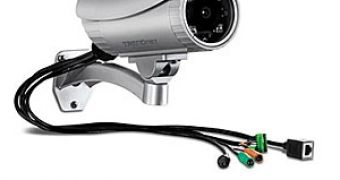TRENDnet seems to be one of those companies that likes to take the IT market by storm when it launches something, and the four announcements of today definitely appear to support this assumption, especially since one of them deals with something only related to networking.
TRENDnet has long been a presence on the worldwide networking industry, always designing and often releasing some new router or other such things.
This once, however, the company has gone a bit beyond the territory it usually treads, releasing not just new adapters and routers, but something else as well.
Basically, according to an official press release, TRENDnet is now offering an outdoor security camera, bearing the name of SecurView Outdoor PoE Megapixel.
It is suited for both daylight and nighttime and comes with an IP66 weatherproof case, meaning that nature won't easily overcome it.
Speaking of nature, it is common for the sun to shine a bit too bright for some people's tastes, possibly affecting the relevance and clarity of the recording.
To deal with the glare, the manufacturer included a sun visor into the default design. Furthermore, at night, powerful megapixel night vision lets it capture images up to a distance of 66 feet.
Of course, TRENDnet also took into account the possibility of less foreign, even human factors possibly posing a threat to the camera. As such, it outfitted it with a so-called vandal resistant enclosure.
As for the actual specifications, those who are interested in numbers will want to know of the 1,280 x 1,024 resolution and the utilization of H.264 image compression.
Finally, the software which is meant to be employed with the camera is one that can monitor up to 32 of them at any one time.
Other assets one might find intriguing are the possibility of tapping into the camera feed with an iPhone, Android smartphone, etc., with the SecurView Mobile application, and the fact that the camera needs no power plug, the energy in the Ethernet cable apparently being enough on its own, thanks to Power over Ethernet (PoE) technology.

 14 DAY TRIAL //
14 DAY TRIAL //